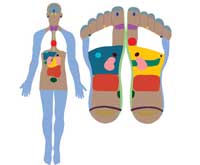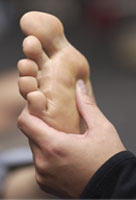A pure, good quality vegetable, nut seed oil is recommended.
It should be cold pressed, unrefined, and additive-free.
Mineral oils should not be used.
The most widely used carrier oil is sweet almond oil(it is suitable for all skin types)
Apricot kernel and peach kernel oils are also excellent for all skin types.
A typical blend that would allow you to carry out approximately 10 treatments would be:
70 mls sweet almond oil
10 mls calendula
10 mls jojoba
10 mls wheat germ
Pure essential oils listed are added to enhance the massage experience, but should be used with great care and keep in mind the contraindications for each oil. They should always be blended with a carrier oil in the following dilution: 3 drops of essential oil to 10 mls(2 teasppons) of carrier oil or 6 drops of essential oil to 20 mls(4 teaspoons) of carrier oil.
Chamomile, Roman (Anthemis Nobilis)
Effects: Balancing, Calming, soothing
Uses: All nervous disorders(anxiety, depression, insomnia, and irritability), female disorders(PMS and Menopause), Aches and pains(in muscles, joints, or organs), sensitive and allergic skin conditions, digestive problems(especially if there is inflammation), and an excellent remedy for babies and children(asthma, colic, skin problems, temper tantrums)
No Contraindications
Eucalyptus (Eucalyptus Globulus)
Effects: Relieves coughs and pain relieving
Uses: all respiratory disorders(excellent chest and throat rub and wonderful inhalant for sinusitis), eases pain of arthritis, rheumatism, and all muscular aches and pains, stimulates the brain aiding in concentration, and prevents infectious diseases from spreading.
Don’t use on babies and children under the age of 2(use chamomile or lavender instead)
Geranium (Pelargonium Graveolens)
Effects: Balancing, Healing, and Uplifting
Uses: wonderful for the nervous system( helps anxiety and depression), PMS and menopause, and excellent for all skin types.
No Contraindications
Lavender (Lavendula Angustifolia)
Effects: it is a universal healer so it works for everything!
Uses: highly beneficial for the nervous system( works for anxiety, depression, insomnia, irritability, and panic attack, reduces high blood pressure, headaches, migraines, arthritis, muscular aches and pains(reduces pain and inflammation, relaxes and tones), all skin care( heals burns, sunburn, acne, eczema, cuts and bruises. Highly recommended for babies and young children due to its gentle action).
No contraindications
Lemon ( Citrus Limonoum)
Effects: Antiseptic, Detoxifying, and Stimulating
Uses: Excellent for digestive system(especially in cases of indigestion and hyperacidity), boosts immune system(accelerates recovery from illness), cuts and wounds, warts, oily skin, and a popular choice for varicose veins.
Avoid strong sunlight immediately after application.
Peppermint (Mentha Piperita)
Effects:Cooling, digestive, Pain relieving, and stimulating.
Uses: All digestive problems( nausea, travel sickness, and inflammatory conditions like irritable bowel syndrome), headaches and migraines(cools and relieves pain), cools down sunburn and relieves itching, excellent for relieving arthritis, rheumatism, and sports injuries.
Store away from homeopathic medicines and do not use on children or babies under the age of 2.
Mandarin (Citrus Aurantium)
Effects: Refreshing, Revitalising, Tonic
Uses: An uplifting oil which dispels anxiety and encourages feeling of joy and happiness. tonic for the digestive system( stimulates the appetite and relieves indigestion), excellent for pregnancy(particularly to combat stretch marks).
Avoid strong sunlight immediately after application.
Rosemary (Rosemarinus Officicnalis)
Effects: Detoxifying, Restorative, Stimulant.
Uses: Clears the head(reducing mental fatigue and aides in concentration), a wonderful tonic and pain reliever for the muscles and joints, encourages hair growth, excellent for coughs, colds, and sinus problems, recommended for digestion (particularly where detoxification is required.. constipation, food poisioning, obesity).
Do not use excessively in first stages of pregnancy or in cases of epilepsy.





